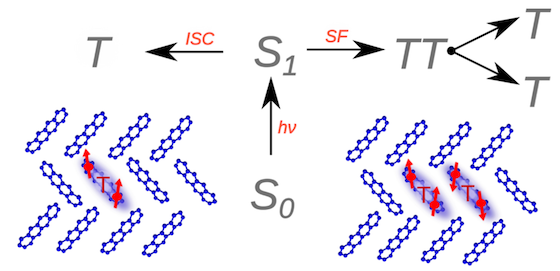Research
Organic Radical Batteries

Our research activities regarding novel batteries aim at developing a comprehensive understanding of the redox processes occurring at the electrodes in Organic Radical Batteries (ORBs). For this purpose we develop and apply tailor-made techniques based on conventional EPR as well as Electrically Detected Magnetic Resonance spectroscopy. These experiments help us to obtain relevant information on charge localisation and oxidation mechanisms on a molecular level. They can further contribute to the identification of loss pathways that may be responsible for the decrease of the battery capacity commonly observed upon repeated cycling.
Our battery-research activities are carried out in close collaboration with the group of Prof. Oleg Levin at St. Petersburg State University. The joint research effort is supported by the G-RISC platform funded by the German Academic Exchange Service (DAAD).
 |
 |
 |
 |
 |
Related Publications
- A. A. Vereshchagin, D. A. Lukyanov, I. R. Kulikov, N. A. Panjwani, E. A. Alekseeva, J. Behrends, O. V. Levin.
The Fast and the Capacious: A [Ni(Salen)]-TEMPO Redox-Conducting Polymer for Organic Batteries.
Batteries & Supercaps 4:336, 2021. - I. Kulikov, N. A. Panjwani, A. A. Vereshchagin, D. Spallek, D. A. Lukianov, E. V. Alekseeva, O. V. Levin, J. Behrends.
Spins at work: probing charging and discharging of organic radical batteries by electron paramagnetic resonance spectroscopy.
Energy & Environmental Science, 2022.
Contact: Jan Behrends
Ilia Kulikov, Naitik Panjwani (AG Bittl)
Singlet Fission

We use advanced EPR and Optically Detected Magnetic Resonance techniques to study the so-called Singlet Fission process in organic semiconductors. In some materials, the absorption of a single photon initially creates one higher-energy, excited particle, called a spin singlet exciton. This singlet can also share its energy with another molecule, forming two lower-energy excitons, rather than just one. These lower-energy particles are called spin "triplet" excitons. Each triplet can move through the molecular structure of the material and be used to produce mobile charge carriers. Thus, singlet fission provides the possibility of increasing the efficiencies of next-generation solar cells.
Our singlet fission activities are carried out in close collaboration with the Optoelectronics Group at the Cavendish Laboratory, University of Cambridge.
 |
 |
Related Publications
- Leah R. Weiss, Sam L. Bayliss, Felix Kraffert, Karl J. Thorley, John E. Anthony, Robert Bittl, Richard H. Friend, Akshay Rao, Neil C. Greenham, Jan Behrends.
Strongly exchange-coupled triplet pairs in an organic semiconductor.
Nat. Phys., 13:176, 2017. - S. L. Bayliss, L. R. Weiss, A. Mitioglu, K. Galkowski, Z. Yang, K. Yunusova, A. Surrente, K. J. Thorley, J. Behrends, R. Bittl, J. E. Anthony, A. Rao, R. H. Friend, P. Plochocka, P. C. M. Christianen, N. C. Greenham, A. D. Chepelianskii.
Site-selective measurement of coupled spin pairs in an organic semiconductor.
P. Natl. Acad. Sci. USA 115:5077, 2018. - Sam L. Bayliss, Felix Kraffert, Rui Wang, Chunfeng Zhang, Robert Bittl, Jan Behrends.
Tuning Spin Dynamics in Crystalline Tetracene.
J. Phys. Chem. Lett., 10:1908, 2019. - S. L. Bayliss, L. R. Weiss, F. Kraffert, D. B. Granger, J. E. Anthony, J. Behrends, R. Bittl.
Probing the Wave Function and Dynamics of the Quintet Multiexciton State with Coherent Control in a Singlet Fission Material.
Physical Review X 10:021070, 2020. - P. J. Budden, L. R. Weiss, M. Müller, N. A. Panjwani, S. Dowland, J. R. Allardice, M. Ganschow, J. Freudenberg, J. Behrends, U. H. F. Bunz, R. H. Friend.
Singlet exciton fission in a modified acene with improved stability and high photoluminescence yield.
Nature Communications 12:1527, 2021.
Contact: Jan Behrends
Naitik Panjwani (AG Bittl)
Transport in Organic Solar Cells

We intend to develop a fundamental understanding of charge transfer and charge transport in organic solar cells. For this purpose we will employ suitable EPR-based techniques. In particular, we will develop the experimental method of transient electrically detected magnetic resonance (transient EDMR). Combining the sensitivity of EDMR and the time resolution of transient EPR will provide us with the possibility to systematically investigate the interplay between charge transfer states, which are generated upon photoexcitation and subsequent charge transfer between donor and acceptor, and the photocurrent in polymer:fullerene blends.
This project is part of the DFG Schwerpunktprogramm 1601on “New Frontiers in Sensitivity für EPR Spectroscopy: From Biological Cells to Nano Materials”.
 |
 |
Related Publications
- Felix Kraffert, Robert Steyrleuthner, Christoph Meier, Robert Bittl, Jan Behrends.
Transient Electrically Detected Magnetic Resonance Spectroscopy applied to Organic Solar Cells.
Appl. Phys. Lett., 107:043302, 2015. - C. Meier, C. Teutloff, J. Behrends, R. Bittl, O. Astakhov, K. Lips.
Triplet excitons as sensitive spin probes for structure analysis of extended defects in microcrystalline silicon.
Phys. Rev. B 94:045302, 2016. - F. Kraffert, D. Bahro, C. Meier, M. Denne, A. Colsmann, J. Behrends.
Transport-related triplet states and hyperfine couplings in organic tandem solar cells probed by pulsed electrically detected magnetic resonance spectroscopy.
J. Magn. Reson. 282:10, 2017. - F. Kraffert, J. Behrends.
Spin-correlated doublet pairs as intermediate states in charge separation processes.
Mol. Phys. 115:2373, 2017.
Contact: Jan Behrends
EPR characterisation of organic materials for photovoltaics and optoelectronics
We aim to advance and use EPR spectroscopy for the characterisation of organic molecules and materials for application in the fields of photovoltaics and optoelectronics. By exploiting a multi-frequency continuous-wave and pulse EPR approach, we aspire to identify correlations between the molecular structure of organic semiconductors and other organic functional materials and their electronic and magnetic properties. Advanced pulse EPR will be used to identify the nature of paramagnetic species in organic materials and characterise interactions with their molecular environment.
This project is part of a Marie Skłodowska Curie fellowship financed by the EU commission through the Horizon 2020 initiative.

Our activities regarding triplet states in twisted acenes are based on a collaboration with the group of Prof. Ori Gidron at the Institute of Chemistry at Hebrew University of Jerusalem.
The research activities related to doping of organic semiconductors are carried out in close collaboration with the groups of Prof. Dieter Neher at University of Potsdam and Prof. Norbert Koch at Humboldt University Berlin.
 |
 |
 |
Related Publications
- C. E. Tait, A. Bedi, O. Gidron, J. Behrends.
Photoexcited triplet states of twisted acenes investigated by Electron Paramagnetic Resonance.
Phys. Chem. Chem. Phys. 21:21588, 2019. - B. Wegner, D. Lungwitz, A. E. Mansour, C. E. Tait, N. Tanaka, T. Zhai, S. Duhm, M. Forster, J. Behrends, Y. Shoji, A. Opitz, U. Scherf, E. J. W. List-Kratochvil, T. Fukushima, N. Koch.
An Organic Borate Salt with Superior p-Doping Capability for Organic Semiconductors.
Advanced Science 7:2001322, 2020. - M. Arvind, C. E. Tait, M. Guerrini, J. Krumland, A. M. Valencia, C. Cocchi, A. E. Mansour, N. Koch, S. Barlow, S. R. Marder, J. Behrends, D. Neher.
Quantitative Analysis of Doping-Induced Polarons and Charge-Transfer Complexes of Poly(3-hexylthiophene) in Solution.
J. Phys. Chem. B 124:7694, 2020. - C. E. Tait, A. Reckwitz, M. Arvind, D. Neher, R. Bittl, J. Behrends.
Spin-spin interactions and spin delocalisation in a doped organic semiconductor probed by EPR spectroscopy.
Phys. Chem. Chem. Phys. 23:13827, 2021.
Contact: Jan Behrends
Claudia Tait